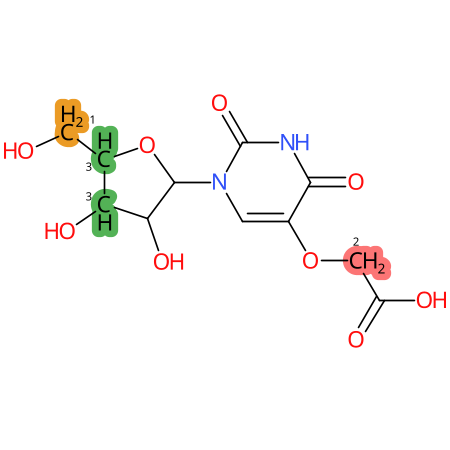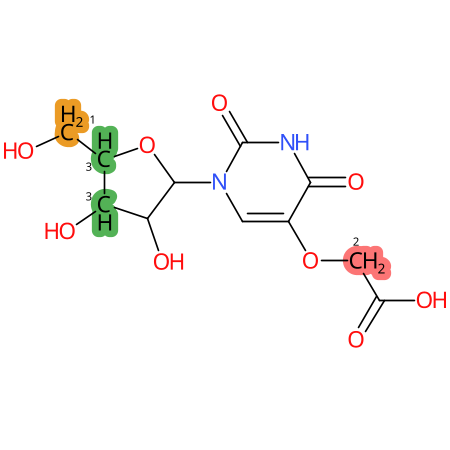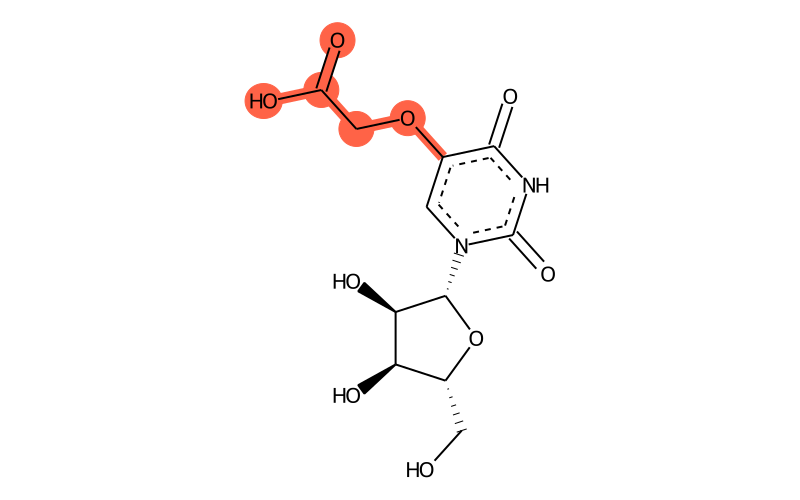Summary
| Full name | uridine 5-oxyacetic acid |
| IUPAC name | 2-[1-[(2R,3R,4S,5R)-3,4-dihydroxy-5-(hydroxymethyl)oxolan-2-yl]-2,4-dioxopyrimidin-5-yl]oxyacetic acid |
| Short name | cmo5U |
| MODOMICS code new | 2000000502U |
| MODOMICS code | 502U |
| Synonyms |
2-[1-[(2R,3R,4S,5R)-3,4-dihydroxy-5-(hydroxymethyl)oxolan-2-yl]-2,4-dioxopyrimidin-5-yl]oxyacetic acid
2-((1-((2R,3R,4S,5R)-3,4-Dihydroxy-5-(hydroxymethyl)tetrahydrofuran-2-yl)-2,4-dioxo-1,2,3,4-tetrahydropyrimidin-5-yl)oxy)acetic acid 28144-25-4 33863-77-3 5-(carboxymethoxy)uridine 5-oxyacetyluridine AC1L4VKW AC1Q5WPL Acetic acid, ((1,2,3,4-tetrahydro-2,4-dioxo-1-beta-D-ribofuranosyl-5-pyrimidinyl)oxy)- Acetic acid,2-[(1,2,3,4-tetrahydro-2,4-dioxo-1-b-D-ribofuranosyl-5-pyrimidinyl)oxy]- AR-1G5490 CHEBI:27240 CID193091 CTK4G0918 DTXSID80182414 J-016986 o(5)u Q27109940 SCHEMBL41703 uridin-5-yloxyacetic acid Uridine-5-oxyacetic acid |
| Nature of the modified residue | Natural |
| RNAMods code | V |
| Residue unique ID | 47 |
| Found in RNA | Yes |
| Related nucleotides | 241 |
| Enzymes |
CmoB (Escherichia coli) |
| Found in phylogeny | Eubacteria |
| Found naturally in RNA types | tRNA |
Chemical information
| Sum formula | C11H14N2O9 |
| Type of moiety | nucleoside |
| Degeneracy | not applicable |
| PubChem ID | 193091 |
| ChEBI ID | 27240 |
| CAS Registry Number | 28144-25-4 |
| Reaxys Registry Number | 848581 |
| SMILES | OC[C@@H]1[C@@H](O)[C@@H](O)[C@H]([n]2c(=O)[nH]c(=O)c(OCC(=O)O)c2)O1 |
| logP | -3.3885 |
| TPSA | 171.31 |
| Number of atoms | 22 |
| Number of Hydrogen Bond Acceptors 1 (HBA1) | 9 |
| Number of Hydrogen Bond Acceptors 2 (HBA2) | 10 |
| Number of Hydrogen Bond Donors (HBD) | 5 |
| InChI | InChI=1S/C11H14N2O9/c14-2-5-7(17)8(18)10(22-5)13-1-4(21-3-6(15)16)9(19)12-11(13)20/h1,5,7-8,10,14,17-18H,2-3H2,(H,15,16)(H,12,19,20)/t5-,7-,8-,10-/m1/s1 |
| InChIKey | RVCNQQGZJWVLIP-VPCXQMTMSA-N |
| Search the molecule in external databases | ChEMBL PubChem Compound Database Ligand Expo WIPO |
| PubChem CID | |
| PubChem SIDs |
* Chemical properties calculated with Open Babel - O'Boyle et al. Open Babel: An open chemical toolbox. J Cheminform 3, 33 (2011) (link)
QM Data:
| Dipole Magnitude [D]: | 7.057225084 |
| Energy [Eh]: | -1213.66999355528 |
| HOMO [eV]: | -9.025 |
| LUMO [eV]: | 0.7064 |
| Gap [eV]: | 9.7314 |
Download QM Data:
| Charges | charge.txt |
Download Structures
| 2D | .png .mol .mol2 .sdf .pdb .smi |
| 3D | .mol .mol2 .sdf .pdb |
Tautomers
| Tautomers SMILES |
OCC1C(O)C(O)C(n2c(=O)[nH]c(=O)c(OCC(O)=O)c2)O1 tautomer #0
OCC1C(O)C(O)C(n2c(=O)[nH]c(=O)c(OC=C(O)O)c2)O1 tautomer #1 OCC1C(O)C(O)C(n2c(O)nc(=O)c(OCC(O)=O)c2)O1 tautomer #2 OCC1C(O)C(O)C(n2c(=O)nc(O)c(OCC(O)=O)c2)O1 tautomer #3 OCC1C(O)C(O)C(n2c(O)nc(=O)c(OC=C(O)O)c2)O1 tautomer #4 OCC1C(O)C(O)C(n2c(=O)nc(O)c(OC=C(O)O)c2)O1 tautomer #5 |
| Tautomer image | Show Image |
Predicted CYP Metabolic Sites
| CYP3A4 | CYP2D6 | CYP2C9 |
|---|---|---|

|

|

|
* CYP Metabolic sites predicted with SMARTCyp. SMARTCyp is a method for prediction of which sites in a molecule that are most liable to metabolism by Cytochrome P450. It has been shown to be applicable to metabolism by the isoforms 1A2, 2A6, 2B6, 2C8, 2C19, 2E1, and 3A4 (CYP3A4), and specific models for the isoform 2C9 (CYP2C9) and isoform 2D6 (CYP2D6). CYP3A4, CYP2D6, and CYP2C9 are the three of the most important enzymes in drug metabolism since they are involved in the metabolism of more than half of the drugs used today. The three top-ranked atoms are highlighted. See: SmartCYP and SmartCYP - background; Patrik Rydberg, David E. Gloriam, Lars Olsen, The SMARTCyp cytochrome P450 metabolism prediction server, Bioinformatics, Volume 26, Issue 23, 1 December 2010, Pages 2988–2989 (link)
LC-MS Information
| Monoisotopic mass | 318.0699 |
| Average mass | 318.237 |
| [M+H]+ | 319.0777 |
| Product ions | 187/169/141 |
| Normalized LC elution time * | 0,54 (Kellner 2014) |
| LC elution order/characteristics | between C and U (Kellner 2014) |
* normalized to guanosine (G), measured with a RP C-18 column with acetonitrile/ammonium acetate as mobile phase.
LC-MS Publications
| Title | Authors | Journal | Details | ||
|---|---|---|---|---|---|
| Profiling of RNA modifications by multiplexed stable isotope labelling. | Kellner S, Neumann J, Rosenkranz D, Lebedeva S, Ketting RF, Zischler H, Schneider D, Helm M. | Chem Commun (Camb). | [details] | 24567952 | - |
Comments
Earlier called the V nucleoside. Base pairs with A, G and U in mRNA. cmo5U (and mcmo5U) is a modification characteristic for gram negative bacteria (E. coli, Protebacteria). Gram positive bacteria (B. subtilis, Firmicutes) have mo5U in this position.
Chemical groups contained
| Type | Subtype |
|---|---|
| other | carboxymethyl |
| other | methoxy |
Reactions producing uridine 5-oxyacetic acid
| Name |
|---|
| ho5U:cmo5U |
| mo5U:cmo5U |
Reactions starting from uridine 5-oxyacetic acid
| Name |
|---|
| cmo5U:mcmo5U |
Publications
| Title | Authors | Journal | Details | ||
|---|---|---|---|---|---|
| The wobble hypothesis revisited: uridine-5-oxyacetic acid is critical for reading of G-ending codons. | Nasvall SJ, Chen P, Bjork GR | RNA | [details] | 17942742 | - |
| Uridin-5-oxy acetic acid: a new minor constituent from E. coli valine transfer RNA I. | Murao K, Saneyoshi M, Harada F, Nishimura S | Biochem Biophys Res Commun | [details] | 4910247 | - |
Last modification of this entry: Sept. 15, 2025
